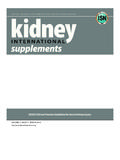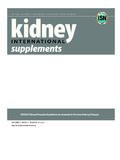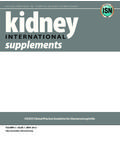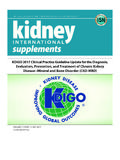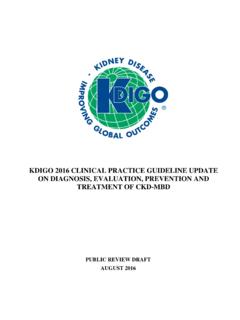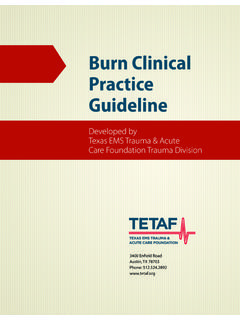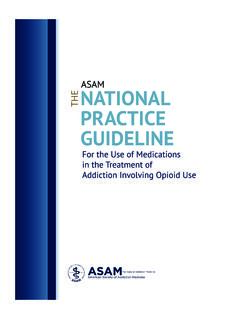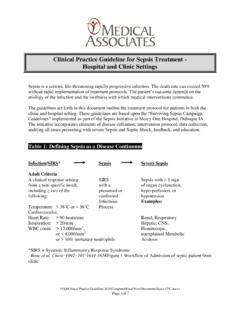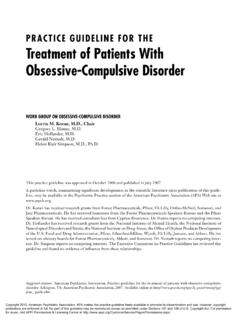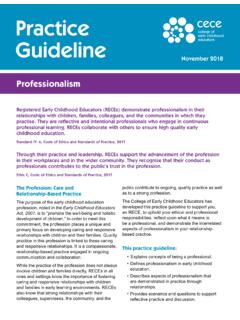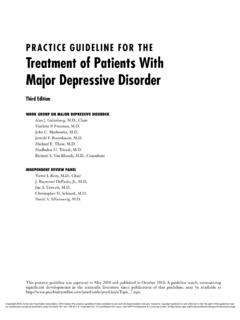Transcription of KDIGO Clinical Practice Guideline for Glomerulonephritis
1 Volume 2 | issue 2 | JuNe 2012 JOurnal Of the internatiOnal SOciety Of nephrOlOgyKDIGO Clinical Practice Guideline for GlomerulonephritisKDIGO Clinical Practice Guidelinefor GlomerulonephritisKDIGO gratefully acknowledges the following consortium of sponsors that make our initiatives possible: Abbott, Amgen,Belo Foundation, Coca-Cola Company, Dole Food Company, Genzyme, Hoffmann-LaRoche, JC Penney, NATCO TheOrganization for Transplant Professionals, NKF-Board of Directors, Novartis, Robert and Jane Cizik Foundation, Roche, Shire,Transwestern Commercial Services, and Statement: KDIGO is supported by a consortium of sponsors and no funding is accepted for the development ofspecific Clinical Practice Guideline for GlomerulonephritisTablesvKDIGO Board MembersviReference KeysviiAbbreviations and AcronymsviiiiNotice139 Foreword140 Work Group Membership141 Abstract142 Summary of Recommendation Statements143 Chapter 1:Introduction154 Chapter 2:General principles in the management of glomerular disease156 Chapter 3:Steroid-sensitive nephrotic syndrome in children163 Chapter 4:Steroid-resistant nephrotic syndrome in children172 Chapter 5:Minimal-change disease in adults177 Chapter 6:Idiopathic focal segmental glomerulosclerosis in adults181 Chapter 7:Idiopathic membranous nephropathy186 Chapter 8:Idiopathic membranoproliferative glomerulonephritis198 Chapter 9:Infection-related glomerulonephritis200 Chapter 10: Immunoglobulin A nephropathy209 Chapter 11: Henoch-Scho nlein purpura nephritis218 Chapter 12: Lupus nephritis221 Chapter 13: Pauci-immune focal and segmental necrotizing glomerulonephritis233 Chapter 14: Anti-glomerular basement membrane antibody glomerulonephritis240 Methods for Guideline development243 Biographic and Disclosure Information252 Acknowledgments258 References259 KDIGOVOL 2 | SUPPLEMENT 2 | JUNE 2012 TABLEST able 1.
2 Definitions of nephrotic syndrome in children164 Table 2. Meta-analyses of RCTs of corticosteroid-sparing agents in children with FR or SD SSNS167 Table 3. RCTs comparing corticosteroid-sparing agents in FR and SD SSNS168 Table 4. Advantages and disadvantages of corticosteroid-sparing agents as first agent for use in FR or SD SSNS169 Table 5. CNI trials in SRNS174 Table 6. Remission in corticosteroid-treated control arms of SRNS randomized trials175 Table 7. Cytotoxic therapy in SRNS175 Table 8. Dosage regimens in MCD178 Table 9. Causes of FSGS182 Table 10. Definitions of nephrotic syndrome in adults with FSGS183 Table 11. Treatment schedules184 Table 12. Reported causes of secondary MN (% in adults)187 Table 13. Reported causes of secondary MN188 Table 14. Definitions of complete and partial remission in IMN188 Table 15. Cyclical corticosteroid/alkylating-agent therapy for IMN (the "Ponticelli Regimen")189 Table 16. Risks and benefits of the cyclical corticosteroid/alkylating-agent regimen in IMN190 Table 17.
3 Contraindications to the use of the cyclical corticosteroid/alkylating-agent regimen in IMN191 Table 18. CNI-based regimens for IMN192 Table 19. Pediatric MN studies197 Table 20. Underlying conditions associated with a membranoproliferative pattern of GN199 Table 21. Infections associated with glomerulonephritis201 Table 22. Treatment of HCV infection according to stages of CKD203 Table 23. Dosage adjustment of drugs for HBV infection according to kidney function (endogenous CrCl)204 Table 24. The spectrum of kidney disease in HIV-infected patients205 Table 25. A clinicopathological classification of schistosomal glomerulopathy206 Table 26. Corticosteroid regimens in patients with IgAN211 Table 27. Definitions of response to therapy in LN222 Table 28. Regimens for initial therapy in class III/class IV LN223 Table 29. Criteria for the diagnosis and classification of relapses of LN229 Table 30. Recommended treatment regimens for ANCA vasculitis with GN234 Table 31. Therapy of anti-GBM GN241 Table 32.
4 Screening criteria for systematic review topics of nontreatment and treatment244 Table 33. Literature search yield of RCTs248 Table 34. Hierarchy of outcomes248 Table 35. Classification of study quality249 Table 36. GRADE system for grading quality of evidence250 Table 37. Final grade for overall quality of evidence250 Table 38. Balance of benefits and harm250 Table 39. KDIGO nomenclature and description for grading recommendations251 Table 40. Determinants of strength of recommendation251 Additional information in the form of supplementary materials can be found online at KDIGOK idney International Supplements(2012)2,vvKDIGO Board MembersGarabed Eknoyan, MDNorbert Lameire, MD, PhDFounding KDIGO Co-ChairsKai-Uwe Eckardt, MDKDIGO Co-ChairBertram L Kasiske, MDKDIGO Co-ChairOmar I Abboud, MD, FRCPS haron Adler, MD, FASNR ajiv Agarwal, MDSharon P Andreoli, MDGavin J Becker, MD, FRACPFred Brown, MBA, FACHED aniel C Cattran, MD, FRCPCA llan J Collins, MD, FACPR osanna Coppo, MDJosef Coresh, MD, PhDRicardo Correa-Rotter, MDAdrian Covic, MD, PhDJonathan C Craig, MBChB, MM (Clin Epi)
5 , DCH, FRACP, PhDAngel de Francisco, MDPaul de Jong, MD, PhDAna Figueiredo, RN, MSc, PhDMohammed Benghanem Gharbi, MDGordon Guyatt, MD, MSc, BSc, FRCPCD avid Harris, MDLai Seong Hooi, MDEnyu Imai, MD, PhDLesley A Inker, MD, MS, FRCPM ichel Jadoul, MDSimon Jenkins, MBE, FRCGPS uhnggwon Kim, MD, PhDMartin K Kuhlmann, MDNathan W Levin, MD, FACPP hilip K-T Li, MD, FRCP, FACPZhi-Hong Liu, MDPablo Massari, MDPeter A McCullough, MD, MPH, FACC, FACPR afique Moosa, MDMiguel C Riella, MDAdibul Hasan Rizvi, MBBS, FRCPB ernardo Rodriquez-Iturbe, MDRobert Schrier, MDJustin Silver, MD, PhDMarcello Tonelli, MD, SM, FRCPCY usuke Tsukamoto, MDTheodor Vogels, MSWA ngela Yee-Moon Wang, MD, PhD, FRCPC hristoph Wanner, MDDavid C Wheeler, MD, FRCPE lena Zakharova, MD, PhDNKF- KDIGO Guideline DEVELOPMENT STAFFK erry Willis, PhD, Senior Vice-President for Scientific ActivitiesMichael Cheung, MA, Guideline Development DirectorSean Slifer, BA, Guideline Development ManagerKidney International Supplements(2012)2, KDIGOR eference KeysGrade*ImplicationsPatientsClinicians PolicyLevel 1 We recommend Most people in your situationwould want the recommendedcourse of action and only a smallproportion would patients should receive therecommended course of recommendation can beevaluated as a candidate fordeveloping a policy or aperformance 2 We suggest The majority of people in yoursituation would want therecommended course of action,but many would choices will be appropriate fordifferent patients.
6 Each patient needs help toarrive at a management decision consistentwith her or his values and recommendation is likely torequire substantial debate andinvolvement of stakeholders beforepolicy can be determined.*The additional category Not Graded was used, typically, to provide guidance based on common sense or where the topic does not allow adequate application of most common examples include recommendations regarding monitoring intervals, counseling, and referral to other Clinical specialists. The ungraded recommendationsare generally written as simple declarative statements, but are not meant to be interpreted as being stronger recommendations than Level 1 or 2 FACTORS OF METRIC UNITS TO SI UNITSNOMENCLATURE AND DESCRIPTION FOR RATING GUIDELINERECOMMENDATIONSW ithin each recommendation, the strength of recommendation is indicated asLevel 1,Level 2,orNot Graded, and the quality of thesupporting evidence is shown asA,B,C, unitsConversion factorSI unitsAlbumin (serum)g/dl10g/lCreatinine (serum) (serum).
7 Metric unit conversion factor SI of evidenceMeaningAHighWe are confident that the true effect lies close to that of the estimate of the true effect is likely to be close to the estimate of the effect, but there is a possibilitythat it is substantially true effect may be substantially different from the estimate of the LowThe estimate of effect is very uncertain, and often will be far from the International Supplements(2012)2, KDIGOK idney International Supplements(2012)2, viiiviiiAbbreviations and AcronymsACE-IAngiotensin-converting enzyme inhibitor(s)ACTHA drenocorticotropic hormoneAKIA cute kidney injuryALMSA spreva Lupus Management StudyANCAA ntineutrophil cytoplasmic antibodyAPOL1 Apolipoprotein L1 APSA ntiphospholipid antibody syndromeARBA ngiotensin-receptor blockerATNA cute tubular necrosisBMIBody mass indexCIConfidence intervalCKDC hronic kidney diseaseCNIC alcineurin inhibitorCrClCreatinine clearanceeGFRE stimated glomerular filtration rateERTE vidence Review TeamESRDEnd-stage renal diseaseFRFrequently relapsingFRNSF requently relapsing nephrotic syndromeFSGSF ocal segmental glomerulosclerosisGBMG lomerular basement membraneGFRG lomerular filtration rateGNGlomerulonephritisGRADEG rading of Recommendations Assessment.
8 Development and EvaluationHAARTH ighly active antiretroviral therapyHBVH epatitis B virusHCVH epatitis C virusHIVANH uman immunodeficiencyvirus associated nephropathyHRHazards ratioHSPH enoch-Scho nlein purpuraHSVH erpes simplex A nephropathyIMNI diopathic membranous nephropathyINRI nternational normalized ratioISKDCI nternational Study of Kidney Disease inChildrenIUInternational unitsKDIGOK idney Disease: Improving Global OutcomesLNLupus nephritisMCDM inimal-change diseaseMDRDM odification of Diet in Renal DiseaseMEPEXM ethylprednisolone or Plasma ExchangeMMFM ycophenolate mofetilMNMembranous nephropathyMPGNM embranoproliferative glomerulonephritisMPOM yeloperoxidaseNCGNN ecrotizing and crescenticglomerulonephritisNSNot significantOROdds ratioPCRP rotein-creatinine (ly)PR3 Proteinase 3 RASR enin-angiotensin systemRAVER ituximab for the Treatment of Wegener sGranulomatosis and Microscopic PolyangiitisRCTR andomized controlled trialRRRelative riskRRTR enal replacement therapySCrSerum creatinineSDSteroid-dependentSLES ystemic lupus erythematosusSRNSS teroid-resistant nephrotic syndromeSSNSS teroid-sensitive nephrotic syndromeTMAT hrombotic microangiopathiesTTPT hrombotic thrombocytopenic purpurauPCRU rine protein:creatinine KDIGON oticeKidney International Supplements(2012)2,139.
9 I: USE OF THE Clinical Practice GUIDELINEThis Clinical Practice Guideline document is based upon systematic literature searches lastconducted in January 2011, supplemented with additional evidence through November is designed to provide information and assist decision-making. It is not intended to define astandard of care, and should not be construed as one, nor should it be interpreted as prescribingan exclusive course of management. Variations in Practice will inevitably and appropriately occurwhen clinicians take into account the needs of individual patients, available resources, andlimitations unique to an institution or type of Practice . Every health-care professional makinguse of these recommendations is responsible for evaluating the appropriateness of applying themin the setting of any particular Clinical situation. The recommendations for research containedwithin this document are general and do not imply a specific II: DISCLOSUREK idney Disease: Improving Global Outcomes ( KDIGO ) makes every effort to avoid any actual orreasonably perceived conflicts of interest that may arise as a result of an outside relationship or apersonal, professional, or business interest of a member of the Work Group.
10 All members of theWork Group are required to complete, sign, and submit a disclosure and attestation formshowing all such relationships that might be perceived or actual conflicts of interest. Thisdocument is updated annually and information is adjusted accordingly. All reported informationwill be printed in the final publication and are on file at the National Kidney Foundation (NKF),Managing Agent for KDIGOKDIGO gratefully acknowledges the following consortium of sponsors that make ourinitiatives possible: Abbott, Amgen, Belo Foundation, Coca-Cola Company, Dole FoodCompany, Genzyme, Hoffmann-LaRoche, JC Penney, NATCO The Organization forTransplant Professionals, NKF-Board of Directors, Novartis, Robert and Jane CizikFoundation, Roche, Shire, Transwestern Commercial Services, and Wyeth. KDIGO issupported by a consortium of sponsors and no funding is accepted for the developmentof specific International Supplements(2012)2, 139139 ForewordKidney International Supplements(2012)2,140; is our hope that this document will serve several usefulpurposes.
